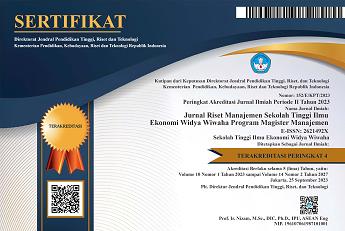Financial Literacy Among Adults: A Methodology Review and Systematic Review with VOS Viewer Application
DOI:
https://doi.org/10.32477/jrm.v12i1.1145Abstract
This research aims to test research with the theme of Financial Literacy methodologically and systematically. The methodology research results show that setting the number of samples. The sample technique chosen greatly determines the success of the research. Incorrect sampling produces suboptimal results and cannot be population-specific. The sample selection technique is random or not influenced by the time required to collect data and regulates the logical sample required by the researcher. For example, regional sampling. The research results are based on a systematic review of Scopus journal data; journals searched that meet the journal search requirements with the keywords Literacy, financial, and Young. Journal entry limits with the subject "Business Management and Accounting Journal", journals in English from 2015 to 2024.54 journals that meet the requirements.7 clusters related to the topic of Financial Literacy in young adults. The clusters are detailed as follows: Cluster 1 (5 Items) are bodega, convenience store, financial inclusion, informal business practices, informal female entrepreneurship; Cluster 2 (5 items): financial attitude, financial awareness, financial knowledge, first-year student, literature review; Cluster 3 (5 items) are attitude toward money, financial behavior, financial literacy, financial planning action, Seci Strategy; Cluster 4 (3 items) are Financial behavior, financial socialization, financial well-being; Cluster 5 (3 items) are Interest in business, Level of financial literacy, Questionaire; Cluster 6 (3 items)are Financial Educations, Financial Fragility, Student load debt; and Cluster 7 (2 items) are Commercial literacy and small business. Then the results of the VOS Viewer also show that the research on Financial Literacy will only be carried out in 2023, and in 2024, most research will be carried out on this theme.
References
Abdullah, N., Sabri, M. F., Mastura, A., & Arif, M. (2019). The Relationship between Attitude towards Money, Financial Literacy and Debt Management with Young Worker’s Financial Well-being. http://www.pertanika.upm.edu.my/
Alshebami, A. S., & Aldhyani, T. H. H. (2022). The Interplay of Social Influence, Financial Literacy, and Saving Behaviour among Saudi Youth and the Moderating Effect of Self-Control. Sustainability (Switzerland), 14(14). https://doi.org/10.3390/su14148780
French, D., & McKillop, D. (2016). Financial literacy and over-indebtedness in low-income households. International Review of Financial Analysis, 48, 1–11. https://doi.org/10.1016/j.irfa.2016.08.004
Kang, G.-L., & Park, C.-W. (2024). The impact of financial literacy and financial management behavior on recognition of startup opportunity. Journal of Infrastructure, Policy and Development, 8(9), 7268. https://doi.org/10.24294/jipd.v8i9.7268
Kawamura, T., Mori, T., Motonishi, T., & Ogawa, K. (2019). Is Financial Literacy Dangerous? Financial Literacy, Behavioral Factors, and Financial Choices of Households. RISS Discussion Paper Series, 77.
Kicová, E., Poniščiaková, O., Rosnerová, Z., & Fabuš, J. (2024). FINANCIAL LITERACY AS AN IMPORTANT ASPECT IN THE AREA OF BUSINESS SUSTAINABILITY: THE CASE OF SLOVAK REPUBLIC. Business: Theory and Practice, 25(2), 523–534. https://doi.org/10.3846/btp.2024.19970
Kovács, E., & Vaskövi, Á. (2020). Pension pessimism in the young generation: Basics or instincts to blame? Business Systems Research, 11(2), 117–131. https://doi.org/10.2478/bsrj-2020-0019
Lopus, J. S., Amidjono, D. S., & Grimes, P. W. (2019). Improving financial literacy of the poor and vulnerable in Indonesia: An empirical analysis. International Review of Economics Education, 32. https://doi.org/10.1016/j.iree.2019.100168
Mamo, J., Vangjel, R., & Zyko, M. (2024). THE INFLUENCE OF INNOVATION ON PERSONAL FINANCIAL MANAGEMENT AND FINANCIAL LITERACY. Risk Governance and Control: Financial Markets and Institutions, 14(2), 54–64. https://doi.org/10.22495/rgcv14i2p6
Ndou, A. (2023). The moderator effect of socioeconomic status on the relationship between parental financial teaching and financial literacy. International Journal of Applied Economics, Finance and Accounting, 17(2), 219–227. https://doi.org/10.33094/ijaefa.v17i2.1110
Nieminen, J. H., Bearman, M., & Tai, J. (2023). How is theory used in assessment and feedback research? A critical review. Assessment and Evaluation in Higher Education, 48(1), 77–94. https://doi.org/10.1080/02602938.2022.2047154
Potrich, A. C. G., & Vieira, K. M. (2018a). Demystifying financial literacy: a behavioral perspective analysis. Management Research Review, 41(9), 1047–1068. https://doi.org/10.1108/MRR-08-2017-0263
Puspawati, D., Abas, N. I., & Permatasari, W. D. (2024). Beyond age stereotypes: Unveiling the investment intentions of young individuals during the COVID-19 pandemic. International Journal of Management and Sustainability, 13(1), 60–75. https://doi.org/10.18488/11.v13i1.3595
Rahyuda, H., & Candradewi, M. R. (2023). Determinants of cryptocurrency investment decisions (Study of students in Bali). Investment Management and Financial Innovations, 20(2), 193–204. https://doi.org/10.21511/imfi.20(2).2023.17
Sangeeta, ., Panwar, A. K. S., & Aggarwal, P. K. (2023). Association between Financial Knowledge, Financial Attitude and Financial Behaviour among Young Population in India. Review of Business and Economics Studies, 10(4), 45–54. https://doi.org/10.26794/2308-944x-2022-10-4-45-54
Santos, dos É. T., Klotzle, M. C., Silva, da G. P. V. J., & Pinto, A. C. F. (2022). How do young low-income university students deal with risk and time preferences in Brazil? Revista Contabilidade e Financas, 59(2). https://doi.org/10.1590/1808-057x20221511.en
Saputra, T., Tjahjono, H. K., & Nuryakin. (2024). BIBLIOMETRIC ANALYSIS OF RESEARCH PUBLICATION TRENDS ON JOB ROTATION SATISFACTION. Revista de Gestao Social e Ambiental, 18(9). https://doi.org/10.24857/rgsa.v18n9-018
Skagerlund, K., Lind, T., Strömbäck, C., Tinghög, G., & Västfjäll, D. (2018). Financial literacy and the role of numeracy–How individuals’ attitude and affinity with numbers influence financial literacy. Journal of Behavioral and Experimental Economics, 74, 18–25. https://doi.org/10.1016/j.socec.2018.03.004
Swiecka, B., Yeşildağ, E., Özen, E., & Grima, S. (2020). Financial literacy: The case of Poland. Sustainability (Switzerland), 12(2). https://doi.org/10.3390/su12020700
Szikszai, Sn. A. M., Bosnyák-Simon, N., & Raffai, C. (2024). Financial Awareness of Young Adults-Experience from A Cross-Border Survey Among Hungarian Speaking Students. Deturope-The Central European Journal of Regional, 16(1), 4–20.
Wahab, A. A., Ahmad, W. M. W., Hashim, A. S. A., & Rusli, M. N. (2024). Financial Literacy and Behavior in Student Financial Planning Action: The Role of SECI Strategy. Jurnal Pengurusan, 72. https://doi.org/10.17576/pengurusan-2024-72-4
Downloads
Published
How to Cite
Issue
Section
License
Copyright (c) 2025 Beta Asteria dan Heru Kurnianto Tjahjono

This work is licensed under a Creative Commons Attribution 4.0 International License.








